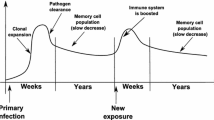Abstract.
To date, mathematical models of the dynamics of infectious disease have consistently focused on understanding the long-term behavior of the interacting components, where the steady state solutions are paramount. However for most acute infections, the long-term behavior of the pathogen population is of little importance to the host and population health. We introduce the notion of transient pathology, where the short-term dynamics of interaction between the immune system and pathogens is the principal focus. We identify the amplifying effect of the absence of a fully operative immune system on the pathogenesis of the initial inoculum, and its implication for the acute severity of the infection. We then formalize the underlying dynamics, and derive two measures of transient pathogenicity: the peak of infection (maximum pathogenic load) and the time to peak of infection, both crucial to understanding the early dynamics of infection and its consequences for early intervention.
Similar content being viewed by others
Author information
Authors and Affiliations
Additional information
Received: 25 January 2000 / Revised version: 30 November 2000 / Published online: 12 October 2001
Rights and permissions
About this article
Cite this article
Mohtashemi, M., Levins, R. Transient dynamics and early diagnostics in infectious disease. J Math Biol 43, 446–470 (2001). https://doi.org/10.1007/s002850100103
Issue Date:
DOI: https://doi.org/10.1007/s002850100103




